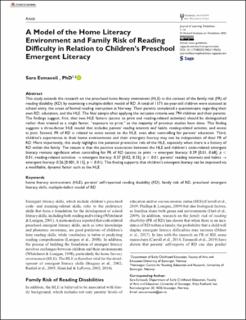| dc.description.abstract | This study extends the research on the preschool home literacy environment (HLE) in the context of the family risk (FR) of reading disability (RD) by examining a multiple-deficit model of RD. A total of 1171 six-year-old children were assessed at school entry, the onset of formal reading instruction in Norway. Their parents completed a questionnaire regarding their own RD, education, and the HLE. The final sample after applying the inclusion criteria was 794 children and their parents. The findings suggest, first, that two HLE factors (access to print and reading-related activities) should be distinguished rather than treated as a single factor, “exposure to print,” as the majority of previous studies have done. This finding suggests a three-factor HLE model that includes parents’ reading interests and habits, reading-related activities, and access to print. Second, FR of RD is related to some extent to the HLE, even after controlling for parents’ education. Third, children’s experiences in their home environments and their emergent literacy may not be independent of their FR of RD. More importantly, this study highlights the potential protective role of the HLE, especially when there is a history of RD within the family. The reason is that the positive association between the HLE and children’s code-related emergent literacy remains significant when controlling for FR of RD (access to print → emergent literacy: 0.39 [0.01, 0.68], p < 0.01; reading-related activities → emergent literacy: 0.37 [0.02, 0.35], p < 0.01; parents’ reading interests and habits → emergent literacy: 0.26 [0.001, 0.15], p < 0.01). This finding supports that children’s emergent literacy can be improved via a modifiable, dynamic factor such as the HLE. | en_US |

